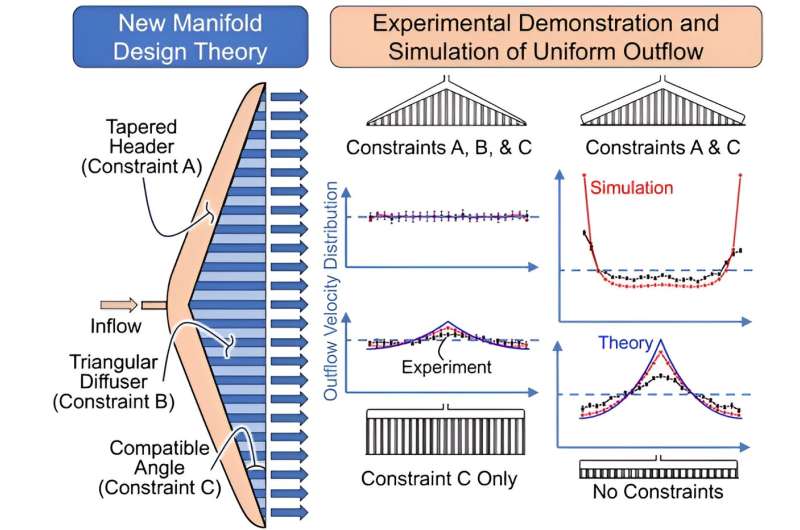This article has been reviewed according to Science X's editorial process and policies. Editors have highlighted the following attributes while ensuring the content's credibility:
fact-checked
peer-reviewed publication
trusted source
proofread
Researchers debut novel manifold design theory

University of Illinois researcher Kyle Smith, along with doctoral students Md Habibur Rahman and Vu Do, master's student Colby Warden, and recent graduate Irwin Loud IV (MSME 2023), have published their new manifold design theory (patent pending) in Physics of Fluids.
Their paper, "A compact, low-pressure manifold with uniform flow at low Reynolds number," was also selected by the journal's editors as a featured article.
"I think the really cool thing from a mechanical engineering standpoint is that in this design paradigm that we have introduced, we are leveraging pressure gradients within the manifold to make flow uniform," said Smith, an associate professor of mechanical science and engineering.
Often categorized according to their purpose (e.g., intake or exhaust), manifolds serve as hollow bodies through which a fluid, such as air or water, passes to transition from one space to another. For example, a car's intake manifold facilitates the flow of ambient air into the engine's cylinders.
The group's theory presents a completely different design strategy than that of longstanding manifold design theories in literature, which prioritize achieving uniform pressure within the manifold. Their theory articulates three design constraints that must be met, the first of which is to strategically taper the cross-section of the manifold's header, or intake.
"Depending on what kind of cross section you use, what shape it has in the header channel, the tapering function takes a different form," Smith said of applying the theory. "These are all physics-based constraints that an engineer can apply to a manifold's design."
The second constraint dictates that the diffuser region, or outlet, should have uniformly spaced channels arranged in a triangular configuration. The third constraint accounts for the angle that should be applied to the region.
"Ultimately, we settled on the tapered-header, triangular-diffuser manifold because it was the only one that theoretically produced uniform flow rate to all outlet channels," Loud said, recalling that they had also explored other configurations such as straight-header, triangular diffuser and straight-header, rectangular-diffuser manifolds.
The paper describes the researchers' experimental process, for which Loud initially 3D-printed manifold prototypes. The group milled subsequent iterations out of clear acrylic and then collected data from dye-based flow visualization, analyzing images of dyed fluid flowing through the manifold into undyed solution.
Rahman said of the experiments that he conducted, "A major challenge was air-bubble entrapment. We ended up overcoming this obstacle by using surfactant. As a new experimentalist, doing these experiments challenged and inspired me." Their experimental results achieved strong agreement with their theory and computer simulations.
"Our paper discusses the comparison of a manifold that satisfies all three constraints versus other manifolds that include some but omit others," Smith said. "We demonstrate that satisfying all three constraints simultaneously produces both the most uniform flow and uniform flow over the widest range of flow rate."
Their article focuses on the design of a single manifold that distributes fluid from one input into a multiplicity of outlets, which is the most challenging manifold configuration to achieve outlet flow uniformity. However, the theory can be applied broadly, including to a system of two manifolds to achieve uniform flow for the intake and exhaust of multiple streams.
Pursuing a new design theory was motivated by phenomena that Smith's research group had observed during desalination experiments, in which salty solution passes through a manifold to flow over an electrode.
"We were initially working on designing a larger version of our battery-like desalination flow cell," Loud recalled of working in the lab with Smith and fellow student Do more than a year earlier. "One of the main considerations was to ensure that the electrolyte was evenly distributed to the leading edge of the electrode."
Do had pointed out that because the size of the leading edge would be doubled in the scaled-up design, the group would need to reconsider how their manifold would send fluid to the electrode. "I'm not sure any of us envisioned how extensive the design process would be," Loud said of the resulting research.
The project holds personal significance for Smith as well. "My dad, Rick Smith, is an inventor without a college degree who designed intake manifolds and other engine parts for race cars," Smith said.
"I was with him at races and his manufacturing shops as a kid. One of my earliest memories is my dad sketching inventions on a Dr. Seuss book of mine. When I realized we had an opportunity to do something with broad impact on manifold design, it got me pretty excited because we could do something innovative in an area that I've been exposed to for a long time."
The tapered-header, triangular-diffuser manifold can achieve uniform flow with less than one quarter of the footprint required for a comparable bifurcating manifold. For electrochemical devices in which pressurized fluid must be distributed across electrodes, such as flow batteries, fuel cells, electrolyzers, and electrochemical desalination cells, uniform distribution should lead to uniform reactions, or in other words, increased efficiency. Smith intends to continue building on the theory to improve fluid management efficiency.
In addition, the group's theory can be adapted for diverse applications as wide ranging as agriculture and the medical field. In addition, their theory may be applied to other flow regimes and other types of fluids.
"There's an opportunity for us to take the basic abstract principles of the theory and build on them in many other contexts," Smith said.
More information: Kyle C. Smith et al, A compact, low-pressure manifold with uniform flow at low Reynolds number, Physics of Fluids (2024). DOI: 10.1063/5.0211073

















